In each of the past 10 years, my favorite fantasy football article every offseason has been Matthew Berry’s “100 facts for the fantasy season” on ESPN.
Six years ago, I was a bartender. The restaurant had closed for the night — it was between two and three in the morning. We were supposed to be cleaning up and prepping for the bartenders working the next morning. I was nowhere to be found. My boss and co-workers were livid.
Unbeknownst to them, I was sitting on a milk crate, shivering in a walk-in refrigerator. My friend had just texted me that Berry’s article had dropped and started sending me his favorite stats from the article. I dropped everything, trying to go over all 4,000 words/100 facts as quickly as possible. My sole source of income could wait — there were stats to devour.
Fast-forward to today, and I no longer have to hide in refrigerators to do fantasy-related research. Now, I work full-time at PFF to do just that. Or, as my friends say, “Someone pays him to sit at home in his underwear and tweet about fantasy football.”
A few weeks ago, Berry released his 14th installment of “100 Facts.” You can find that here. In it, he writes, “This is Year 14 now and — often imitated, never duplicated — it's always the first column I write every fantasy football season. ”
“Often imitated, never duplicated.”
True, and guilty.
Maybe even cooler than getting paid to tweet in my boxers: This year, Berry gave me permission to shamelessly rip off one of his most-well-known articles, my all-time favorite fantasy article, the one that inspired me to quit that bartending job and try to break into this industry.
Without further ado, here are the three fantasy stats on each NFL team that you absolutely need to know before you draft this year:
[Editor's Note: All EDGE and ELITE subscribers have access to all of PFF's fantasy projections, rankings and more. Subscribe today to gain access ahead of your league's draft!]
Arizona Cardinals
1. Last season, and among all 64 Power-5 teams, Kliff Kingsbury’s Texas Tech offense ranked third in snaps per game (84.8), fourth in pass percentage (57.9%), and fifth in targets to running backs (78).
2. Andy Isabella’s 2018 season was our highest-graded season by any wide receiver (min. 40 receptions) since we first started grading college players in 2014.
3A. Kyler Murray scored 500.5 fantasy points in 2018, or the seventh-most by any NCAA quarterback since at least 2000.
3B. One of the (only) four quarterbacks to outscore him? Johnny Manziel in 2012.
3C. His offensive coordinator that year? Kliff Kingsbury.
Atlanta Falcons
1. Over the past six seasons, Julio Jones has ranked first (2.93), first (3.08), first (3.12), first (3.04), fifth (2.72), and first (2.75) in yards per route run.
2A. Matt Ryan ranked second among quarterbacks in total fantasy points last year (for the second time in three seasons). Somehow, that’s putting it lightly — he scored 355.0 fantasy points, or the 14th-most by any quarterback in any season ever.
2B. Throughout his career, 26 of Ryan's 37 highest-scoring fantasy games (70%) have come in a dome. Last year he averaged 23.8 fantasy points per game in a dome but only 20.1 fantasy points per game when playing outdoors.
2C. He plays outdoors in only three of 16 games this season.
3. Calvin Ridley averaged 5.8 targets per game last year and ranked fifth of 82 wide receivers in fantasy points per target (2.29). Over the past seven seasons, Dirk Koetter’s WR2 has averaged 7.0 targets per game.
Baltimore Ravens
1A. Lamar Jackson holds two of the five highest-scoring fantasy seasons by any NCAA quarterback since at least 2000 — ranking first in 2016 and fifth in 2017.
1B. In his first season in the NFL, Jackson broke the PFF-era record (2007-2018) in fantasy points per dropback, averaging 0.83. For perspective, this was 21% better than Patrick Mahomes’ average last season.
1C. More than any other quarterback, Jackson is the best ADP value (QB19) in current drafts.
2A. Mark Andrews was Jackson’s most productive receiver, comprising a team-high 26% of Jackson’s passing yards on just 12% of his throws.
2B. He also ranked sixth-best in PFF grade and fifth-best in yards per route run (2.01). His 552 receiving yards was the 22nd-most by any rookie tight end in NFL history.
3A. Last season, once Jackson took over as the team’s starter, Baltimore’s running backs ranked second in carries, first in rushing yards, and first in yards per carry (a whopping 5.34).
3B. Mark Ingram has finished as a fantasy RB1 in four of his last five seasons. Over this span, he ranks first in yards per carry (4.71), fourth in yards after contact per attempt (2.90), and third in drop rate (3%).
Buffalo Bills
1A. Over the final six weeks of last season, Josh Allen ranked first among all quarterbacks in fantasy points per game (24.2).
1B. Over one three-game stretch, Allen totaled 335 rushing yards, or the most by any quarterback of the modern era. Allen also averaged 9.3 rushing fantasy points per game, which ranks third-most by any quarterback since 2000.
2. Last season, an Allen dropback was worth just 0.68 fantasy points to his receivers, which ranked second-worst of 31 qualifying quarterbacks.
3. In games LeSean McCoy did not leave early due to injury, he averaged 8.9 fantasy points per game when Allen played. When Allen sat out, McCoy averaged 15.7 fantasy points per game.
Carolina Panthers
1. In 2018, Christian McCaffrey scored:
1A. More rushing fantasy points than Melvin Gordon, Nick Chubb, or Marlon Mack;
1B. More receiving fantasy points than Odell Beckham Jr., Amari Cooper, or Tyler Lockett;
1C. More passing fantasy points than Nathan Peterman, DeShone Kizer, or Mark Sanchez. (Those three combined for 158 total pass attempts.)
2. Last season, D.J. Moore ranked first in missed tackles forced per reception (0.31), second in yards after the catch per reception (7.91), and fifth in yards per target average (10.3).
3. Cam Newton has finished as one of PFF’s 15 highest-graded-passers just once in his eight-year career.
Chicago Bears
1. Since we began tracking college players in 2014, only twice has a running back eclipsed 100 missed tackles forced in a single season. Both times it was by David Montgomery, in 2017 (109) and 2018 (102).
2A. Last season, Mitchell Trubisky averaged a 103.7 passer rating when targeting wide receivers out of the slot. When targeting wide receivers split out wide, he averaged a passer rating of just 82.4.
2B. In 2017, Trubisky’s favorite target was slot wide receiver Kendall Wright, who amassed 51% more targets than the next-closest player. In 2016 (in college), Trubisky’s favorite target was another slot wide receiver, Ryan Switzer, who drew 44% more targets than the next-closest player.
2C. In 2017 (in college), Anthony Miller ranked sixth-best of 179 qualifying wide receivers in yards per route run from the slot (3.43).
2D. Last season, Miller ran 69% of his routes from the slot.
2E. He also dealt with a bad shoulder injury (since Week 3) that popped out “maybe five to six times” throughout the season.
3. Last season Trubisky ranked 11th at the position in fantasy points per game, despite ranking 33rd of 38 qualifiers in PFF grade.
Cincinnati Bengals
1A. Tyler Eifert has played in just 35% of Cincinnati’s games over the past five seasons.
1B. Over this span, he leads all tight ends in fantasy points per target (2.33) and ranks fourth in fantasy points per route run (0.45).
2A. Last season, Joe Mixon saw just 56% of the team’s running back targets (25th-most) in games Giovani Bernard was active.
2B. In Mixon’s final season of college he averaged 2.70 yards per route run, which ranks top-six of the PFF College era (2014-2018).
3. Last season, Tyler Boyd averaged:
3A. 15.8 fantasy points per game (19th-most);
3B. 16.7 fantasy points per game when Andy Dalton was active (15th-most);
3C. 17.4 fantasy points per game when A.J. Green was active (12th-most);
3D. He ranks 25th at the position in current ADP.
Cleveland Browns
1. Odell Beckham Jr. saw an accurate pass (on-frame or in-stride) on 50% of his targets last year, the lowest rate among wide receivers. From Week 9 (when Freddie Kitchens started calling the team’s plays) until the end of the regular season, Baker Mayfield ranked fourth in accurate throw percentage, behind only Tom Brady, Drew Brees, and Patrick Mahomes.
2A. From Week 9 until the end of the regular season, Mayfield also ranked 10th among quarterbacks in fantasy points per game (19.0), third in adjusted net yards per attempt (8.33), fifth in passer rating (106.2), and sixth in PFF pass grade (81.2).
2B. Kitchens will continue calling the team’s offensive plays this year, but Cleveland’s new offensive coordinator is Todd Monken, who in his first season as a play-caller, oversaw a Tampa Bay Buccaneers offense that totaled 5,125 passing yards — or the fourth-most by any team in NFL history.
3. Cleveland’s passing attack has been getting all of the attention, but…
3A. Nick Chubb was PFF’s highest-graded running back in 2018. He led the league in elusive rating (103.3), while also averaging 4.47 yards after contact per attempt, which ranks best by any running back this past decade.
3B. Kareem Hunt ranks behind only Alvin Kamara in PFF grade over the past two seasons (88.9), and also leads all running backs over this span in elusive rating (77.9)
3C. Last season, Duke Johnson ranked second-best in elusive rating (94.8), behind only Chubb, and has ranked top-two in receiving missed tackles forced in three of the past four seasons.
Dallas Cowboys
1A. Amari Cooper joined the Cowboys in Week 9. From that point on until the end of the regular season, Dak Prescott ranked sixth among quarterbacks in total fantasy points scored.
1B. Since entering the league, Prescott has finished 10th, 10th, and sixth in fantasy points scored.
1C. He ranks 17th in ADP.
2A. Including the postseason (11 total games), Cooper averaged 17.9 fantasy points per game with Dallas last season, which would have ranked 10th-best last year.
2B. Over the past two seasons, Cooper has as many games (seven) with 80-plus receiving yards as he does games of 10 or fewer receiving yards.
2C. In 2017, Cooper scored 52% of his fantasy points in just three games (most). In 2018, Cooper scored 52% of his fantasy points in just three games (most).
2D. This means that the other 79% of the time you were starting him he was averaging just 5.5 (2017) and 7.0 (2018) fantasy points per game. Those numbers would have ranked outside of the top-75 in both seasons.
2E. Of 72 qualifying receivers since 2015, Jason Witten ranks best in targets per dropped pass (54.4), while Cooper ranks worst (11.9).
3. Across Ezekiel Elliott‘s last 16 games (including the postseason), he totaled 335 carries and 101 targets. By weighted opportunity, that’d be worth 354.9 points, or what would rank eighth-most since targets became a stat (1992).
Denver Broncos
1. Phillip Lindsay scored 222.8 fantasy points last year — the second-most ever by an undrafted rookie (at any position) since the NFL merger (1970).
2A. Noah Fant’s combine was historically great, earning top-12 marks (since 2000) in the 40-yard-dash, vertical jump, broad jump, and three-cone.
2B. Throughout his college career, Fant averaged one drop every 7.0 catchable targets. Over the past six NFL seasons, there are only two instances of a tight end drawing more than 50 targets and recording a worse drop rate than Fant’s.
3. Cornerback Chris Harris Jr. has been thrown at 644 times in 132 career games. Over that span, only 10 wide receivers have ever caught a touchdown pass against him. Only eight times has a player ever totaled more than 50 yards against him in any game, and only once has a player totaled over 85 yards.
Detroit Lions
1. Over the past three seasons, 51% of Matthew Stafford’s passing yards have come after the catch, the highest rate in the league.
2A. Last season, Kerryon Johnson averaged 11.8 carries per game. All other Detroit running backs combined to average 15.7 carries per game.
2B. Last season, Johnson averaged 5.43 yards per carry. All other Detroit running backs combined to average just 3.42 yards per carry. This differential of 2.01 led the league, and a 3.42 yards-per-carry average would have ranked last among all NFL teams.
3. In Darrell Bevell’s last 11 seasons in the NFL, his teams have ranked top-five in run percentage six times and top-12 eight times.
Reading stat after stat can be tedious, I know, but just think of the edge you’ll have over your opponents after reading all 96 of these. In an effort to save you from stat-overload, this is your first of two scheduled intermissions.
How are you doing? Is your mind blown? Feel free to take a breather, bookmark this page, and come back later. Or, are you someone like me (circa 2014 and every year since), and you just can’t ever seem to get enough fantasy stat goodness? In that case, grab a notebook, grab some popcorn, and trek on.
Here’s a gif of Mike Tolbert doing “The Carlton” to help break up the monotony. Hypnotic, I know.
Green Bay Packers
1A. Last season, Aaron Rodgers ranked just 22nd in fantasy points per dropback (0.46) — the worst finish of his career.
1B. Over the past four seasons, Rodgers has ranked 22nd (2018), eighth, 15th, and 25th in depth-adjusted completion percentage.
1C. This was my attempt at trying to explain the discrepancy between Rodgers’ ADP (QB3) and our projections (QB9).
1D. Though, really, he’s Aaron freaking Rodgers. He leads all quarterbacks in fantasy points per game since 2011, and he was playing hurt last year (since Week 1, with a tibial plateau fracture and a sprained MCL).
2. Over the past two seasons, Aaron Jones is our highest-graded runner (90.4) and leads all 87 qualifying running backs in yards per carry (5.50).
3A. Over the past 10 seasons, Rodgers has targeted wide receivers out of the slot on 25.6% of his throws (fourth-most among quarterbacks) with a 111.6 passer rating (best).
3B. Geronimo Allison is the team’s starting slot wide receiver.
3C. Allison played in only four full games last season but averaged 7.3 targets and 15.0 fantasy points per game across these games.
3D. Since Rodgers was named the starter in 2008, Green Bay’s WR2 has yielded two WR1 seasons, four WR2 seasons, two WR3 seasons, and two WR4 seasons for fantasy.
3E. Allison is currently priced as a WR5 for fantasy (ADP WR52).
Houston Texans
1. Deshaun Watson leads all quarterbacks (min. 18 games) in fantasy points per game over the past two seasons (by 1.5).
2A. Over the past two seasons, Will Fuller averages 14.0 fantasy points per game when he’s played at least 50% of the team’s snaps.
2B. 14.0 fantasy points per game would have ranked 23rd-best last year.
2C. He ranks 33rd by ADP.
3A. Including the postseason, Keke Coutee saw at least 50% of the team’s snaps in just five games. Across those games, he averaged 9.4 targets per game and 17.2 fantasy points per game.
3B. For perspective, 9.4 targets per game would have ranked seventh and 17.2 fantasy points per game would have ranked 13th among all wide receivers last year.
3C. He ranks 45th by ADP.
Indianapolis Colts
1. Last season, 70% of Marlon Mack's fantasy points came in games where Indianapolis won by 14 or more points. In all other games he averaged just 9.0 fantasy points per game (would have ranked 46th).
2. Over the past three seasons, Andrew Luck has finished as a top-12 quarterback in 74% of his games – the highest rate in the league.
3. Last season, Eric Ebron was out-snapped (331 to 164) and out-targeted (32 to 22) by Jack Doyle in games both players were active.
Jacksonville Jaguars
1. The greatest quarterback season of all-time by adjusted yards per attempt (min. 300 attempts, 1,244 qualifying seasons)? That would be Nick Foles‘ 2013 (10.5).
2A. Among all 63 running backs with at least 150 carries over the past two seasons, Leonard Fournette ranks 48th in PFF run grade, 49th in yards per carry, and 50th in yards after contact per attempt.
2B. Luckily, research shows efficiency is nowhere near as important as volume for fantasy running backs.
3A. In 2017 (postseason included), Fournette ranked sixth in fantasy points per game (18.1) and third in touches per game (23.8).
3B. In 2018, Fournette ranked 12th in fantasy points per game (15.1) and seventh in touches per game (19.4).
3C. Fournette played in eight games last year but saw the field in just 26 (of a potential 32) quarters, due to ejection and injury.
3D. Once adjusted for that, it becomes clear Fournette saw little dropoff in usage or production, averaging 18.5 fantasy points (ninth-most) and 23.8 touches (second-most) per four quarters.
Kansas City Chiefs
1A. In 2018, his first full season as a starter, Patrick Mahomes scored the most fantasy points of any quarterback in any season all-time (417.1).
1B. Last season, he outscored the No. 6 quarterback by 6.5 fantasy points per game.
1C. He outscored the No. 12 quarterback by 8.4 fantasy points per game.
2A. In 2018, Travis Kelce totaled 294.6 fantasy points — the fourth-most by any tight end in any season all-time.
2B. Last season, he outscored the No. 6 tight end by 8.2 fantasy points per game.
2C. He outscored No. 12 tight end by 10.3 fantasy points per game.
2D. For perspective, that’s larger than the differential between the highest-scoring wide receiver (Tyreek Hill) and the No. 32 (Dede Westbrook).
2E. Not necessarily a fact, but definitely my strongly held opinion: Kelce should be drafted well ahead of Mahomes in all (non-2QB) leagues, and may well be worth a late-first-round pick.
3. In 12 of the last 15 seasons, Andy Reid’s RB1 has finished top-eight among running backs in fantasy points per game. No other head coach or offensive coordinator comes close.
Los Angeles Chargers
1. Last season Austin Ekeler ranked:
1A. Sixth of 61 running backs in PFF grade (83.6);
1B. Seventh of 56 running backs in elusive rating (67.6);
1C. Sixth of 56 running backs in yards per carry average (5.23);
1D. Seventh of 31 running backs in yards per target average (7.62).
1E. All of these numbers ranked better than Melvin Gordon, who hit 4.0 yards per carry for just the first time in his career last year, and is now threatening to holdout.
1F. Ekeler ranks just 31st among running backs in ADP.
2A. In 2016-2017, Hunter Henry ranked first in passer rating when targeted (143.7), first in fantasy points per target (2.33), third in PFF grade (90.1), and third in yards per route run (2.02).
2B. Over this span, he averaged 10.4 fantasy points per game in games he was targeted. This was despite the fact that he played on just 55% of the team’s snaps.
2C. Antonio Gates is no longer on the team.
3A. Last season, 33% of Mike Williams fantasy points came on touchdowns, which ranked third-most among wide receivers.
3B. He averaged just 41.5 receiving yards per game, which ranked 55th-most.
3C. He scored 4.6 touchdowns above his expectation, which ranks as the 18th-largest positive differential this past decade.
3D. Despite the aforementioned low snap share, Henry (who is now healthy after missing all 16 games last year) led the team in end zone targets (20) in 2016-2017.
Los Angeles Rams
1A. Los Angeles averaged 433.0 running back fantasy points per season across 2017-2018.
1B. If the Rams repeat that number in 2019, Todd Gurley would need just a 52% market share to beat his current ADP (RB10).
1C. Charles Robinson is projecting a 65% (volume-based) market share for Gurley in 2019.
1D. Of course, this makes him seem like a great value at ADP. But here’s one problem — I might have 96 mind-blowing stats on just Darrell Henderson alone.
2. Last season, in games all three wide receivers played on at least 50% of the team’s snaps:
2A. Brandin Cooks averaged 19.5 fantasy points per game (would have ranked seventh-best if over a full season);
2B. Robert Woods averaged 17.5 (12th-best);
2C. Cooper Kupp averaged 16.3 (18th-best).
3. Over the past two seasons, Jared Goff averages a 103.1 passer rating (sixth-best) when Kupp was on the field (24 games). When he’s missed time (11 games), his passer rating falls to just 85.7 (27th).
Miami Dolphins
1A. The Dolphins ranked last in plays per game (54.9) under Adam Gase last season.
1B. If they’re perfectly average in that department next season, we should expect their offense to run 8.0 more plays per game.
1C. For perspective, that would have been worth an additional 60.1 fantasy points to Kenyan Drake — the difference between him ranking 14th at the position and ninth.
2A. The Dolphins ranked last in PFF passing grade (45.8) last season.
2B. Ryan Fitzpatrick ranked third-best in fantasy points per dropback (0.62) and ninth-best in PFF grade last year (84.4).
2C. Yes, I double-checked these stats.
3. If you’ll allow me to stretch the definition of a “fact” — by any metric you want to look at, Albert Wilson is probably the most underrated wide receiver in the NFL.
Minnesota Vikings
1A. Kirk Cousins ranked 12th in fantasy points last year, after finishes of sixth, fifth, and eighth over the prior three seasons.
1B. Somehow, he ranks 20th by ADP this year.
2. At 20 years old, Irv Smith Jr. totaled 710 receiving yards at Alabama last year, a feat O.J. Howard never accomplished in four seasons there. He also posted a near-perfect passer rating when targeted (157.7), along with 2.56 yards per route run, which ranks top-five of the PFF era.
3A. Despite battling injuries last season, Dalvin Cook averaged 0.27 missed tackles forced per touch, which led the league and ranks fifth-best by any running back this past decade.
3B. From Week 11 (his first week off the injury report) until the end of last season, Cook played on 76% of the team’s snaps and averaged 15.7 fantasy points per game. Over the past two seasons, excluding games Cook was not on the injury report and didn’t leave early due to injury, he averaged 15.8 fantasy points per game. Both numbers would have ranked 11th-best last year.
3C. Latavius Murray is no longer on the team; Gary Kubiak now is.
3D. In 12 seasons as an offensive coordinator, Kubiak’s offenses have ranked top-five in rushing yards nine times and top-12 12 times.
3E. In his last year in the league, Kubiak led the league in outside zone runs and outside zone run percentage.
3F. Over the last two seasons and of 38 qualifying running backs, Cook ranks fourth-best in yards per carry when running in outside zone.
New England Patriots
1A. Since 2010 (when Rob Gronkowski entered the league), Tom Brady averages 20.1 fantasy points per game with Gronkowski on the field, but only 17.5 when he’s missed time.
1B. That would have been the difference between finishing eighth and 18th in fantasy last year.
1C. Without Gronkowski, Brady falls from 103.1 in passer rating to 88.1.
1D. For perspective, of the 23 quarterbacks to attempt at least 400 passes last year, only three quarterbacks returned a passer rating worse than 88.1 — Sam Darnold, Blake Bortles, and Case Keenum.
2. Julian Edelman averages 18.6 fantasy points per game across his last 16 games (postseason included) without Gronkowski on the field. For perspective, that would have ranked ninth-best at the position last year.
3A. Last year, James White averaged 13.4 fantasy points per game when Rex Burkhead was on the field and didn’t leave early due to injury. When Burkhead was inactive, White averaged 21.4 fantasy points per game.
3B. Last year, James White averaged 14.8 fantasy points per game when Sony Michel was on the field and didn’t leave early due to injury. When Michel was inactive, White averaged 23.1 fantasy points per game.
New Orleans Saints
1. There are 895 instances of a running back totaling at least 100 carries in a single season. Within that sample, Alvin Kamara owns the seasons ranking first (1.59, 2017) and fourth-best (1.29, 2018) all-time by fantasy points per touch.
2. Over the past seven seasons the Saints have ranked first, first, first, second, first, second, first, and first in team running back fantasy points per game.
3. Over the past two seasons, Drew Brees ranks fourth-best in fantasy points per dropback (0.54) but third-worst in dropbacks per game (34.6).
Still with me? We're more than two-thirds of the way done — only 10 teams or 30 stats to go. Now might be a good time to remind you to subscribe to PFF — to get more great stats like this every week — and to follow me on twitter. As part of your final intermission, please enjoy this gif of Jared Oldrick doing “the Pee Wee Herman dance” after recording a sack.
New York Giants
1. Since entering the league, Evan Engram averages 8.9 fantasy points per game when Odell Beckham Jr. saw the field, and 13.3 fantasy points per game when he’s missed time. For perspective, 13.3 fantasy points per game would have ranked fifth-best at the position last year.
2. Among all wide receivers with at least 50 targets (79 or more qualifiers in each season), Golden Tate has ranked top-four in missed tackles forced per reception in each of the last eight seasons. He’s ranked top-four in yards after the catch per reception in seven of these eight seasons.
3A. Last season, Saquon Barkley totaled 641 yards on 16 carries of 20-plus yards. Those numbers rank third- and fifth-most, respectively, across the PFF era (2007-2018).
3B. On average, running backs who totaled 400-plus yards on carries that gained 20-plus yards saw that number drop by 56% in the following season.
3C. Excluding carries of 20-plus yards, Barkley averaged just 2.72 yards per carry — worst of 256 qualifying seasons within the PFF era.
New York Jets
1. Sam Darnold ranked as just our 29th-highest-graded passer last season (of 38 qualifiers) but also ranked second-best across the final four weeks of the season.
2A. Le’Veon Bell leads all players all-time in fantasy points per game (21.9).
2B. Okay, sure, but he also hasn’t played football in a year-and-a-half and now has a head coach who didn’t even want to sign him.
2C. A head coach who wants to monitor Bell’s usage, concerned Bell (who averaged 10.4 snaps per game more than any other running back from 2013 to 2017) doesn’t get “fatigued” or “worn down.”
2D. A head coach whose offense has ranked 31st, 29th, 31st, and 27th in pace of play in game-neutral situations over the past four years.
2E. A head coach who… Well, you get the picture.
3. (Stretching our definitions of “fact” again.) Undrafted rookie Greg Dortch needs to be owned in all dynasty leagues.
Oakland Raiders
1A. Since 2013, Antonio Brown totals 9,145 yards — the most receiving yards by any player through any six-year stretch in NFL history.
1B. Over this span, he’s ranked second, first, first, first, first, and fifth at the position in fantasy points scored.
1C. Over this span, he’s graded out 27th, second, fourth, first, first, and third among wide receivers.
1D. Throughout his career, Brown averages 8.4 fantasy points per game without Ben Roethlisberger on the field (10 such games). In all other games (130), Brown averages 19.4 fantasy points per game.
2. Over the past three seasons, no wide receiver has seen more deep targets than Brown (126), and no wide receiver has scored more fantasy points on deep targets than Brown. Tyrell Williams also ranks 12th in fantasy points scored on deep targets over this span. Across this stretch, Derek Carr attempted a deep pass on just 10.4% of his total attempts (third-lowest of 30 qualifiers).
3A. Josh Jacobs just became the first running back drafted in Round 1 (since 2000) who never had even one season with 1,000-plus yards from scrimmage in college.
3B. Jacobs never saw bell-cow usage but did flash bell-cow upside in college, exceling as both a receiver and as a runner in short-yardage situations.
3C. Jacobs led all combine-invite running backs from this class in career yards per target (10.4) and yards per route run (2.06).
3D. Last year, 41.0% of Jacobs’ carries resulted in either a first down or a touchdown in 2018, the highest rate in the country.
3E. After making the selection, Jon Gruden had this to say of Jacobs, “I think he’s going to be a centerpiece at some point… My expectation for him — if you’re listening, Josh — I encourage you to get some rest because we’re going to run you a lot. We’re going to give you a great opportunity.”
Philadelphia Eagles
1. Miles Sanders was stuck behind Saquon Barkley for his first two seasons at Penn State but replaced him nicely last year. In 2018, Sanders actually totaled more rushing yards than Barkley gained the year prior, and on only three more carries.
2. Over the past two seasons, among all quarterbacks to play in at least 18 games, Carson Wentz ranks behind only Deshaun Watson and Russell Wilson in fantasy points per game (19.8).
3A. DeSean Jackson has averaged a 1.82 yards per route run or more with nine different quarterbacks. (1.82 yards per route run would have ranked 30th of 96 wide receivers last year.)
3B. The only quarterback he hasn’t? Jameis Winston (1.53).
3C. Jackson totals 4,657 yards from deep passes across the last 10 years, which is 1,259 (31%) more than the next-closest receiver (Calvin Johnson, who saw only three fewer deep targets).
3D. Over the past two seasons, Wentz ranks seventh-best of 26 qualifying quarterbacks in deep ball accuracy percentage. Winston ranks fifth-worst.
3E. Jackson ranked ninth-best in yards per route run (2.27) last year and 18th at the position in PFF grade (81.1) over the past two seasons.
Pittsburgh Steelers
1. Over the past six seasons, Pittsburgh’s non-Le’Veon Bell RB1 (by snaps) — players like James Conner, DeAngelo Williams, Jaylen Samuels, Felix Jones, Fitzgerald Toussaint, Isaac Redman, and Jonathan Dwyer — averaged 18.8 fantasy points per game across 35 games. That's just 3.3 fantasy points per game off Bell's average and would have ranked ninth-best last year.
2A. Vance McDonald ranked 10th in total fantasy points last year, despite ranking just 17th in target market share and playing on only 50% of the team’s snaps.
2B. In that limited role, he stood out in efficiency, ranking fourth-best (of 35 qualifiers) in yards after the catch per reception (7.7), third-best in yards after contact per reception (4.3), and second-best in missed tackles forced per reception (0.29).
2C. He will reportedly be used in an every-down role this season.
3A. JuJu Smith-Schuster turns 23 in November and has totaled 494.6 fantasy points across his 30-game career.
3B. For perspective, only Randy Moss has ever totaled more fantasy points before turning 23, and Larry Fitzgerald ranks right behind Smith-Schuster.
3C. In games Brown was inactive, Smith-Schuster averaged 9.0 targets and 21.2 fantasy points per game. In all other games he averaged 7.8 targets per game and 15.7 fantasy points per game.
San Francisco 49ers
1A. Last season, George Kittle led all tight ends in PFF grade and PFF receiving grade. He also led all tight ends in receiving yards (1,377), yards per route run (2.83), yards after the catch (873), yards after the catch per reception (9.9), and missed tackles forced (17).
1B. 1,377 receiving yards was also the most by any tight end in NFL history, but that wasn’t the only record he broke last year.
1C. His yards per route run was the best of the PFF era (since 2007). His 873 yards after the catch in 2018 was also a PFF-era record and by 217 more (and 28% better) than the next-closest season (Gronkowski, 2011). His 9.9 yards after the catch per reception in 2018 also made a new record.
1D. Kittle did this while catching passes from three different quarterbacks, all of whom graded below average and ranked below average in passer rating.
2A. Last season, Kittle averaged 0.62 fantasy points per route with Nick Mullens under center. He averaged 0.40 fantasy points per route with Jimmy Garoppolo under center.
2B. He ran 489 routes last year.
2C. At those paces, a full season with Mullens would have been worth 103.8 fantasy points more than a full season with Garoppolo.
3. Last season, Dante Pettis led all wide receivers in yards after the catch per reception (7.93). He averaged a whopping 18.7 fantasy points per game across the last four games he started and finished.
Seattle Seahawks
1A. Russell Wilson has ranked top-three in fantasy points per dropback in six of seven seasons.
1B. However, he’s ranked inside the top-12 in dropbacks per game only once, and inside the top-20 only twice.
1C. If Seattle had ranked only average in dropbacks per game over this stretch, he’d lead all quarterbacks in fantasy points per game since entering the league.
2. Over the past two seasons, 71% of D.K. Metcalf‘s yards have come on just two routes (the go route or hitch).
3A. Last season, Wilson recorded a perfect passer rating (158.3) when targeting Tyler Lockett. This is the first perfect WR rating (passer rating when targeted) ever recorded in the PFF era.
3B. Among all 160 wide receivers to see at least 200 targets this past decade, Lockett ranks first overall in WR rating (127.4).
3C. Lockett averaged 14.9 yards per target in 2018, which is the most by any wide receiver with at least 25 targets this past decade.
3D. Lockett also averaged 3.28 fantasy points per target, which is the most by any wide receiver in any season (of 1,772 qualifying seasons) since targets became a stat (1992).
3E. Lockett has been targeted on just 14.8% of his career routes, the eighth-lowest mark among 87 qualifying wide receivers.
3F. Last season, Lockett ranked 16th in fantasy points but 57th in targets.
3G. Doug Baldwin retired.
Tampa Bay Buccaneers
1A. Over the past two seasons, Jameis Winston has averaged 20.6 (2018) and 17.8 (2017) fantasy points per game when playing on at least 75% of the team’s snaps.
1B. For reference, those numbers would have ranked sixth- (last year) and eighth-best (in 2017) at the position.
2A. Winston ranks second-best in passer rating when targeting tight ends (120.7) but in the bottom-five when targeting any other position.
2B. Throughout Winston’s career, tight ends have comprised 19.6% of his attempts, but 20.6% of his yards, a whopping 38.6% of his touchdowns, and just 13.8% of his interceptions.
2C. Last year, O.J. Howard:
2D. Ranked second among all tight ends in PFF grade (89.4);
2E. Averaged 2.83 yards per route run, which ranks 15th-best of the PFF era (2007-2018);
2F. Averaged 12.0 yards per target, which ranked third-best of the PFF era (of 429 qualifying seasons);
2G. Tied for fifth at the position in fantasy points per game (12.1), despite splitting time with Cameron Brate and leaving two games early due to injury.
3A. Last season, Chris Godwin ranked fourth among Tampa Bay’s wide receivers in targets per game. He still ranked 27th at the position in total fantasy points.
3B. Bruce Arians said Godwin can be “close to a 100-catch guy” in 2019.
3C. Over the past 10 seasons, Arians’ WR2 has averaged 104.3 targets per season, or what would have ranked 25th-most last year.
3D. If we exclude 2017 (Jaron Brown) and 2016 (J.J. Nelson), that number jumps to 112.5, or what would have ranked 18th last year.
Tennessee Titans
1. Last season, Corey Davis saw 43% of his targets come when lined up against top-25-graded cornerbacks, the highest rate in the league among 94 qualifying WRs.
2A. Prior to last season, Delanie Walker finished sixth, sixth, third, and seventh among tight ends in fantasy points per game.
2B. He currently ranks 13th by ADP.
3A. Derrick Henry combined to total 78.0 fantasy points across just two games last season (Weeks 14-15).
3B. Those two games made up a whopping 38% of his total fantasy points for the year.
3C. Outside of those two games, he averaged just 8.9 fantasy points per game.
3D. This was the difference between him finishing 22nd and 45th at the position in fantasy points per game.
Washington Redskins
1A. This time last year, Derrius Guice had an early-fourth-round ADP.
1B. At the combine this year, Jay Gruden told Matthew Berry, “[Guice] doesn't have to come off the field on third down.” Berry continued, “Gruden expanded on that, saying that though LSU never really used him in the pass game, the Redskins discovered last year in practice and OTAs that's he's a really good pass-catcher, and they will use him in that role this season.”
1C. My opinion here, but if this is true and Guice is the starter, he’d be a screaming value with an ADP in the seventh-round.
1D. If it’s not, expect extreme week-to-week inconsistency like with what we saw from Adrian Peterson last year.
1E. Last season, Peterson averaged 16.7 fantasy points per game in victories (seven such games) and 8.5 fantasy points per game in losses (eight such games).
1F. Though, keep in mind Vegas is projecting Washington to win one fewer game this season, and Peterson and Chris Thompson might not relinquish their committee roles too easily.
2. Josh Doctson led all Washington wide receivers in fantasy points last year but still finished just 66th overall.
3A. Over the past four seasons, Jordan Reed leads all tight ends in fantasy points per snap (0.30) and fantasy points per route run (0.49).
3B. Over this span (including the postseason), Reed averages 15.2 fantasy points per game when playing on at least 40% of the team’s snaps.
3C. Last season, 15.2 fantasy points per game would have ranked fourth-best among tight ends (or best in 2016) and 20th-best among wide receivers.
3D. Reed entered the league in 2013. In that time, he’s spent 47% of Washington’s games on the injury report.
3E. Per Redskins beat writers Ryan Fowler and Kyle Stackpole, Reed “has had perhaps the best camp of his career.”
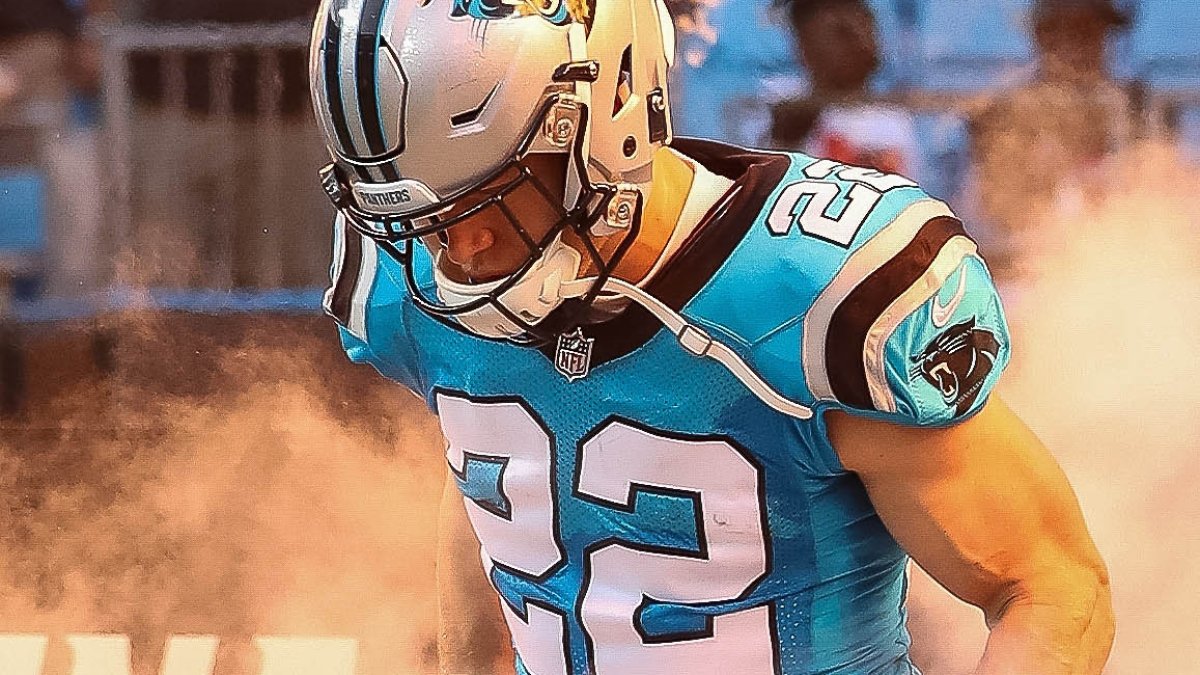
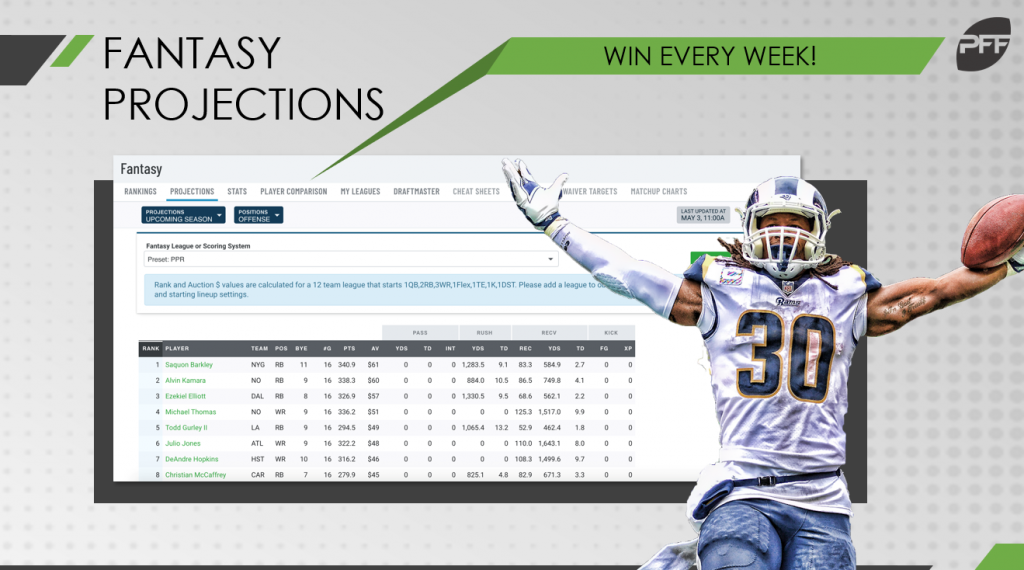
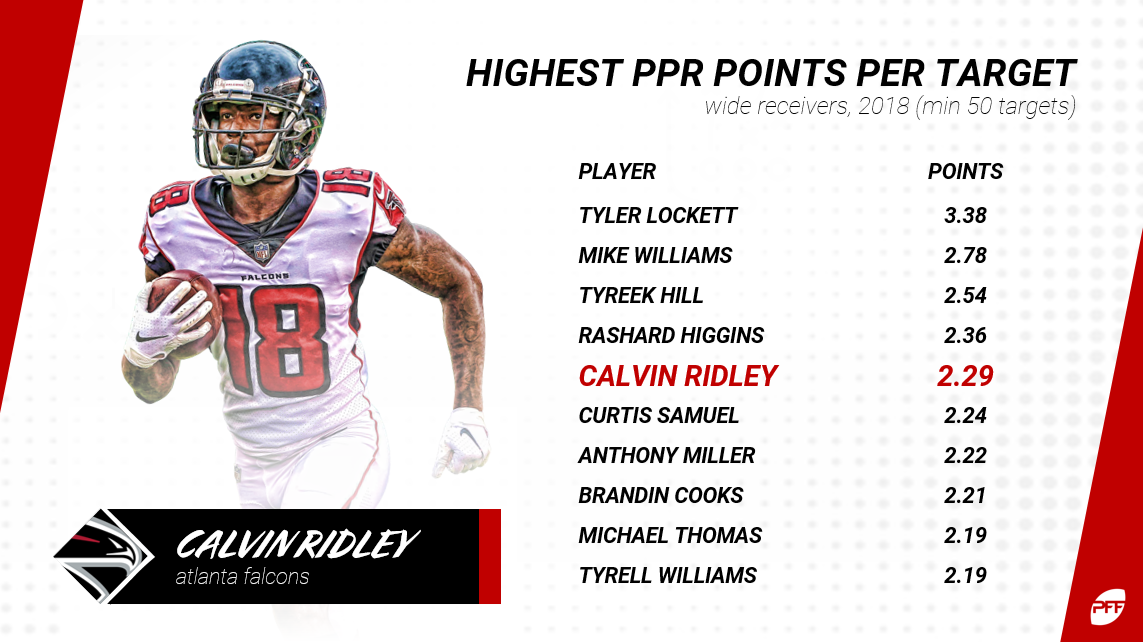
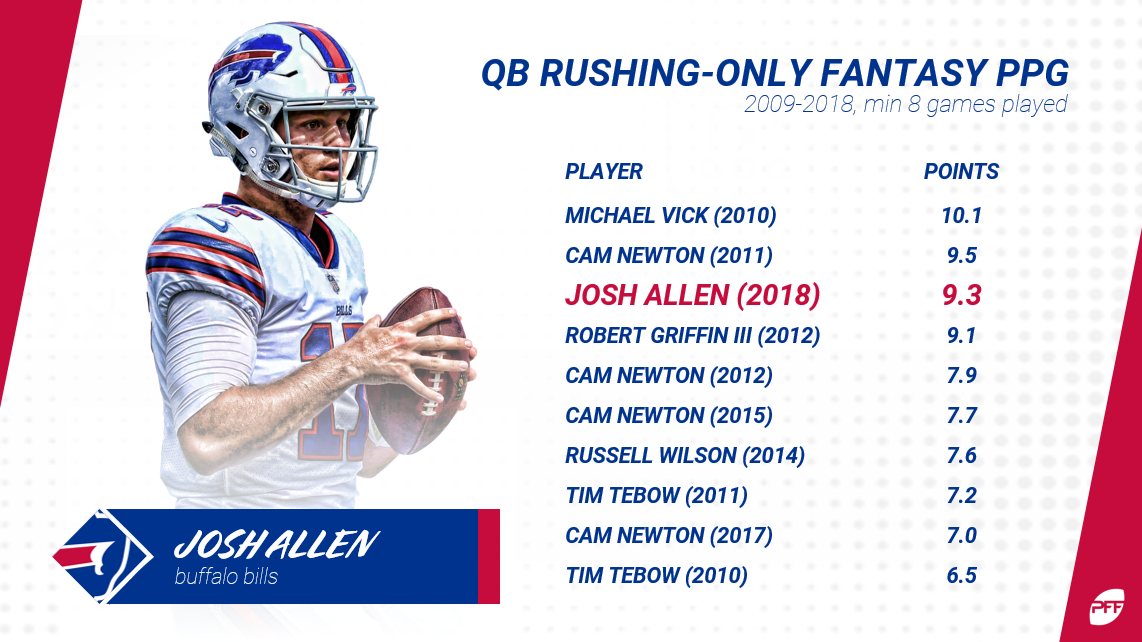
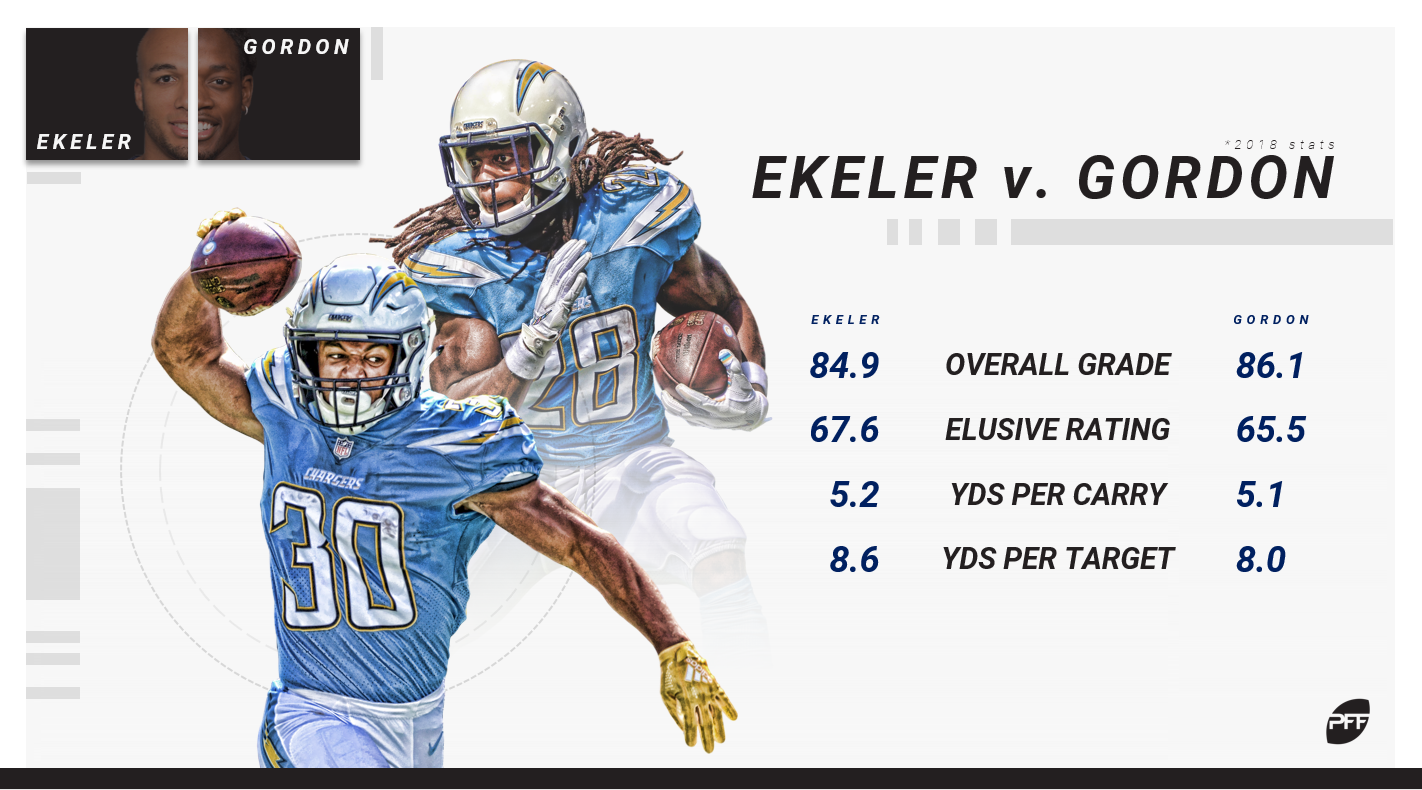
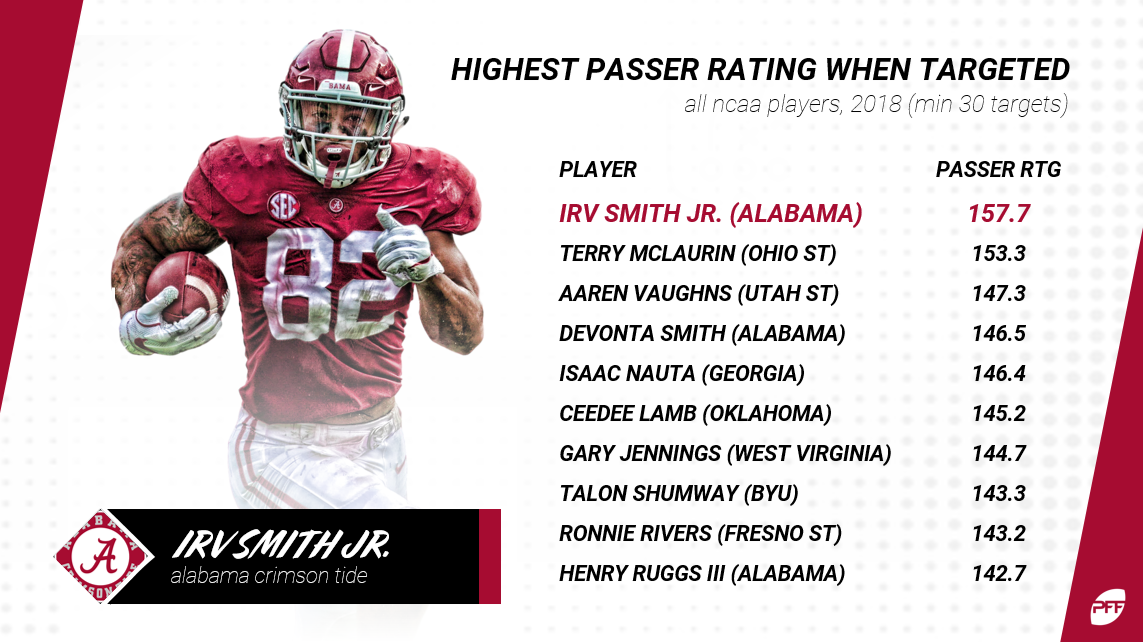

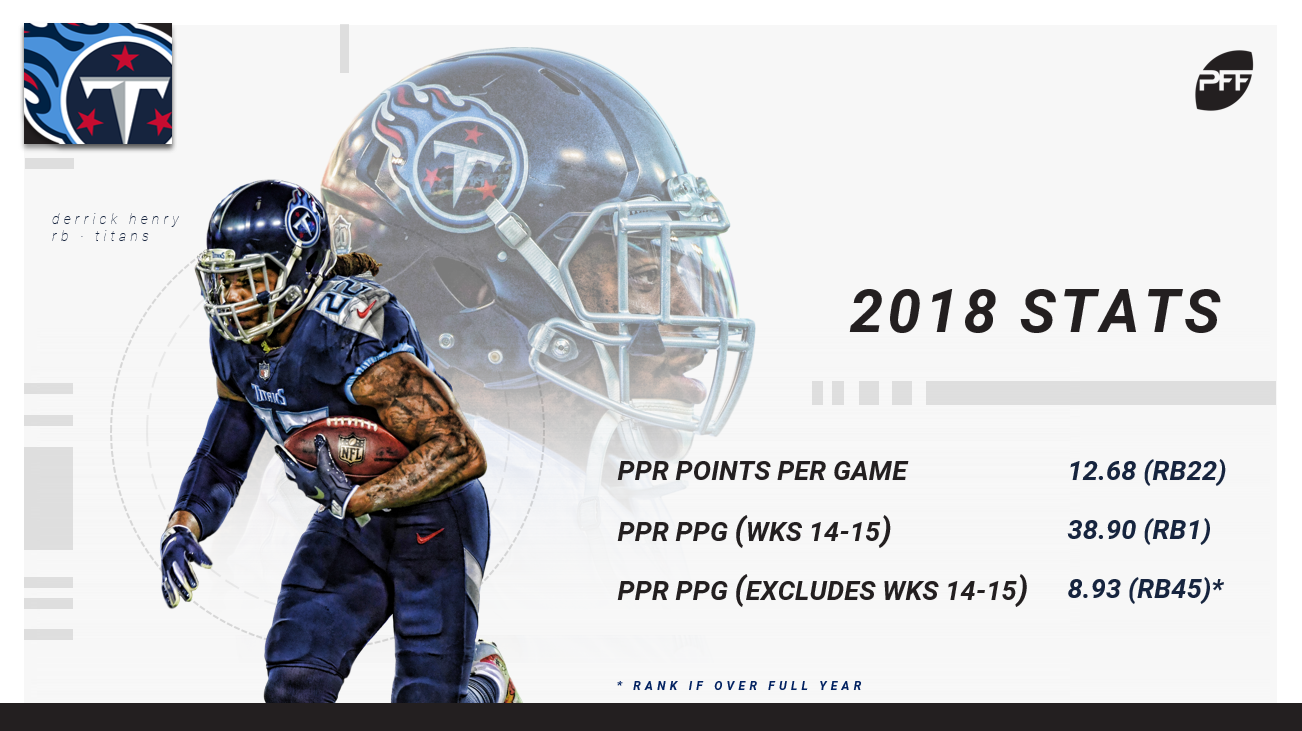


 © 2024 PFF - all rights reserved.
© 2024 PFF - all rights reserved.